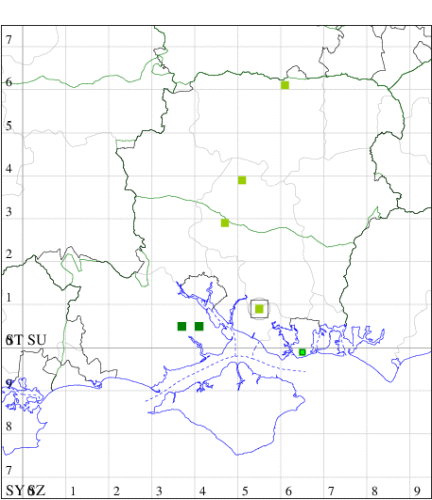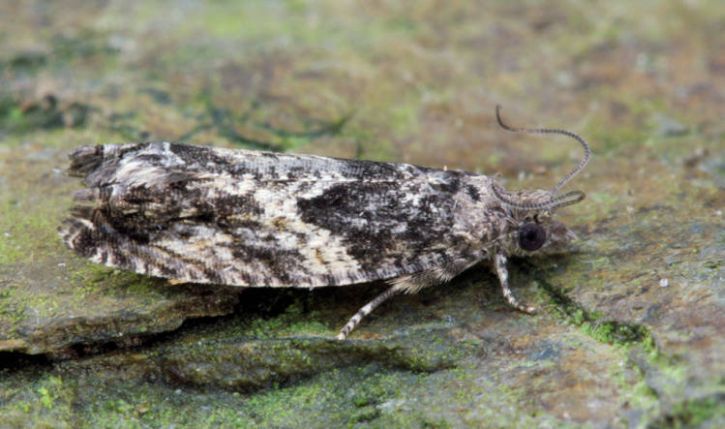Epinotia cinereana
Checklist Number49.256 [B&F: 1138a]
Verification
Record requires retention of specimen until confirmed, and may require dissection. Consult with CMR if unsure
Classification
| Family: | Tortricidae |
| Subfamily: | Olethreutinae |
| Genus: | Epinotia |
| Species: | cinereana |
| Authority: | (Haworth, 1811) |
Recently separated from Epinotia nisella. Distribution in Hampshire and Isle of Wight unclear - reported from scattered localities in VC11 and VC12 to date.
Although Epinotia cinereana was considered a distinct species and was included in Pierce & Metcalfeis The Genitalia of the British Tortricidae (1914) which documented clear differences in the genitalia, this treatment was not followed by Bradley et al in their 1972 British checklist; Razowski also omitted the species from his European Tortricidae publications.
Mutanen et al, 2012 (Zootaxa) discussed the two species in their Holarctic study and laid out a clear case for their separation.
Epinotia cinereana has the blackish or reddish blotches in the forewing absent and gives an overall greyish impression showing blackish streaks in the forewing. The larvae are said to feed between spun leaves of Aspen Populus tremula. Epinotia nisella usually shows a more highly patterned forewing with blotches of black or reddish in the forewing or along the dorsum; in rare instances they can appear wholly greyish like E. cinereana. For new localities, and where Aspen is not found, specimens should be retained for examination of the genitalia for separation.
Records of this species would be particularly welcome, especially from localities which are known to be close to Aspen stands.
Although Epinotia cinereana was considered a distinct species and was included in Pierce & Metcalfeis The Genitalia of the British Tortricidae (1914) which documented clear differences in the genitalia, this treatment was not followed by Bradley et al in their 1972 British checklist; Razowski also omitted the species from his European Tortricidae publications.
Mutanen et al, 2012 (Zootaxa) discussed the two species in their Holarctic study and laid out a clear case for their separation.
Epinotia cinereana has the blackish or reddish blotches in the forewing absent and gives an overall greyish impression showing blackish streaks in the forewing. The larvae are said to feed between spun leaves of Aspen Populus tremula. Epinotia nisella usually shows a more highly patterned forewing with blotches of black or reddish in the forewing or along the dorsum; in rare instances they can appear wholly greyish like E. cinereana. For new localities, and where Aspen is not found, specimens should be retained for examination of the genitalia for separation.
Records of this species would be particularly welcome, especially from localities which are known to be close to Aspen stands.


The abundance in each month is indicated as follows:
 No records
No records Very occasional
Very occasional Irregular
Irregular Uncommon
Uncommon Off-peak, but not unusual
Off-peak, but not unusual Off-peak, but not unusual
Off-peak, but not unusual Main flight time
Main flight time| J | F | M | A | M | J | J | A | S | O | N | D | |
|---|---|---|---|---|---|---|---|---|---|---|---|---|
| Adult |  |  |  |  |  |  |  |  |  |  |  |  |
| Larval |  |  |  |  |  |  |  |  |  |  |  |  |
Records by week (adult)
Records by week (larval)
VC11 South Hampshire
| Site | Date | Quantity | Recorder | Stage |
|---|---|---|---|---|
| Southsea (SZ69) | 24/07/1982 | one | John R Langmaid | Adult |
| Southsea (SZ69) | 21/07/2004 | one | John R Langmaid | Adult |
| Botley Wood (SU50) | 16/07/2014 | one | Keith Wheeler | Adult |
| Botley Wood (SU50) | 18/07/2014 | two | Keith Wheeler | Adult |
| Botley Wood (SU50) | 20/07/2014 | two | Keith Wheeler | Adult |
| Botley Wood (SU50) | 21/07/2014 | one | Keith Wheeler | Adult |
| Botley Wood (SU50) | 24/07/2014 | one | Keith Wheeler | Adult |
| Botley Wood (SU50) | 11/09/2015 | one | Maurice Opie | Adult |
| Winchester (SU42) | 27/07/2018 | one | Tim Walker | Adult |
| Culverley, NF (SU30) | 19/07/2020 | one | Chris Lewis | Adult |
| Portsmouth (SU60) | 07/07/2023 | one | Ian Thirlwell | Adult |
| Winchester (SU42) | 25/07/2023 | one | Tim Walker | Adult |
| Winchester (SU42) | 28/07/2023 | one | Tim Walker | Adult |
VC12 North Hampshire
| Site | Date | Quantity | Recorder | Stage |
|---|---|---|---|---|
| Weston Colley (SU53) | 28/08/2010 | one | David G Green | Adult |
| Pamber Forest (SU66) | 24/09/2016 | one | Graham Dennis | Adult |
| Inhams Copse, Pamber (SU66) | 05/08/2024 | two | Graham Dennis | Adult |
| Inhams Copse, Pamber (SU66) | 12/08/2024 | four | Graham Dennis | Adult |
| Inhams Copse, Pamber (SU66) | 19/08/2024 | three | Graham Dennis | Adult |
| Inhams Copse, Pamber (SU66) | 28/08/2024 | two | Graham Dennis | Adult |

